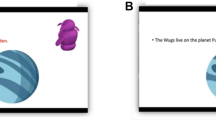Abstract
In this paper, we investigated the effects of guided and unguided style VR learning on user attention and retained knowledge. We conducted a study where users performed guided or unguided style learning in the virtual environment while user attention was measured through an eye tracking system and physiological sensors. The virtual environment contained the five specific events associated with different stimuli, but the guided task was designed to provide the specific goals whereas the unguided task asked the user to actively search for the interesting items. The results showed that the unguided task followed by the guided task made a considerable learning effect by giving a preview to the user. In addition, tactile feedback, sudden view point change, unique appearance and behavior, and sound stimuli played an important factor in increasing human attention states that also induced enhancing human memory about VR experience.
Preview
Unable to display preview. Download preview PDF.
Similar content being viewed by others
References
Cho, B.H., et al.: Attention Enhancement System using Virtual Reality and EEG Biofeedback. Proceedings of the IEEE Virtual Reality (2002)
Mantovani, F.: VR Learning: Potential and Challenges for the Use of 3D Environments in Education and Trainings. CyberPshchology (2003)
Bricken, M.: Virtual Reality Learning Environments: Potential and Challenges. In: Proceedings of the SIGGRAPH 1991, ACM SIGGRAPH, pp. 178–184 (1991)
Dede, C., Salzman, M., Loftin, R.B., Ash, K.: Using Virtual Reality Technology to Convey Abstract Scientific Concepts. Learning the Sciences of the 21st Century: research, Design and Implementing Advanced Technology Learning Environments (1997)
Furness, A., Winn, W., Yu, R.: The Impact of Three Dimensional Immersive Virtual Environments on Modern Pedagogy: Global Change, VR and Learning. In: Proceedings of Workshops in Seattle, Washington, and Loughborough, England (1997)
Salzman, M.C., Dede, C., McGlynn, D., Loftin, R.B.: ScienceSpace: Lessons for Designing Immersive Virtual Realities. In: Proceedings of the CHI 1996: ACM conference on Human Factors in Computing Systems, pp. 89–90. ACM, New York (1996)
Salzman, M.C., Dede, C., Loftin, R.B.: Learner-centered design of sensorily immersive microworlds using a virtual reality interface. In: Proceedings of the AI-ED 1995: 7th World Conference on Artificial Intelligence in Education, pp. 554–561. Association for Advancement of Computer Education, Charlottesville (1995)
Whitelock, D., Brna, P., Holland, S.: What is the Value of Virtual Reality for Conceptual Learning? Towards a Theoretical Framework. In: Proceedings of the Euro AI-Ed: European Conference on AI in Education. University of Leeds, Leeds (1996)
Allison, D., Hodges, L.F.: Virtual Reality for Education? In: VRST, Seoul, Korea. ACM, New York (2000) 1-58113-316-2/00/0010
Brown, D.J., Wilson, J.R.: LIVE: Learning in Virtual Environments, Ability. The Journal of the British Computer Society 15, 24–25 (1995)
Spencer, K.M., Polich, J.: Poststimulus EEG spectral analysis and P300: Attention, task, and probability. Psychophysiology 36, 220–232 (1999)
Healey, J.A.: Wearable and Automotive Systems for Affect Recognition from Physiology. PhD thesis at the MIT (2000)
Tripathi, C.K., Mukundan, C., Mathew, T.L.: Attentional modulation of heart rate variability (HRV) during execution of PC based cognitive tasks. Ind J Aerospace Med 47(1) (2003)
Chen, D., Vertegaal, R.: Using Mental Load for Managing Interruptions. Physiologically Attentive User Interfaces (2004)
Raposa, J.: Biofeedback in Educational Entertainment. Master thesis at Interaction Design institute Ivrea (2003)
Kim, S.H., et al.: Clinical Study on Cerebral Lateralization of Attention by Using Heart Rate. Journal of Korean Neurological Association 5(2) (December 1987)
Youngblut, C.: Educational Uses of Virtual Reality Technology. Institute for Defense Analyses (January 1998)
Duchowski, A.T., et al.: Binocular Eye Tracking in VR for Visual Inspection Training. In: Proceedings of VRST (2001)
Yee, H., Pattanaik, S., Greenberg, D.P.: Spatiotemporal Sensitivity and Visual Attention for Efficient Rendering of Dynamic Environments. ACM Transactions on Graphics 20(1), 39–65 (2001)
Iqbal, S.T., Zheng, X.S., Bailey, B.P.: Task-Evoked Pupillary Response to Mental Workload in Human-Computer Interaction. In: CHI 2004, Vienna, Austria, April 24-29. ACM, New York (2004) 1-58113-703-6/04/0004
Homan, W.J.: Virtual Reality: Real Promises and False Expectations. EMI: Educational Media International 31(4), 224–227 (1994)
Schroeder, R.: Learning from Virtual Reality Applications in Education. Virtual Reality 1(1), 33–40 (1995)
Cronin, P.: Report on the Applications of Virtual Reality Technology to Education. HCRC. University of Edinburgh, Edinburgh (1997), Electronic Document, http://www.cogsci.ed.ac.uk/~paulus/vr.htm
Rose, H.: Assessing Learning in VR: Towards Developing a Paradigm, Virtual Reality Roving Vehicles (VRRV) Project. HITL Publication TR-95-1: Seattle, WA: Human Interface Technology Laboratory (1995)
Carr, K., England, R.: Simulated and Virtual Realities: Elements of Perception. Taylor and Francis, London (1995)
Hjelm, S.I., Browall, C.: Brainball using brain activity for cool competition. Media lab Europe
Schwarz, G.: Specific Problems in Interpretation of Absolute Values of Spectral Edge Frequency (SEF) in comparison to Bispectral Index (BIS) for Assessing Depth of Anesthesia. The Internet Journal of Neuromonitoring ISSN: 1531-300X
Li, Q., Sun, L., Duan, J.: Web Page Viewing Behavior of Users: An Eye-Tracking Study. IEEE, Los Alamitos (2005) 0-7803-8971-9/05/
Duchowski, A.T.: A Breadth-First Survey of Eye Tracking Applications, Behavior Research Methods. Instruments, and Computers (BRMIC) 34(4), 455–470 (2002)
Picard, R.E., Vyzas, E., Healy, J.: Toward Machine Emotional Intelligence: Analysis of Affective Physiological State. IEEE Transactions on Pattern Analysis and Machine Intelligence 23(10), 1175–1191 (2001)
YGdrasil, http://www.evl.uic.edu/yg/overview.html
Author information
Authors and Affiliations
Editor information
Editors and Affiliations
Rights and permissions
Copyright information
© 2006 Springer-Verlag Berlin Heidelberg
About this paper
Cite this paper
Goo, J.J. et al. (2006). Effects of Guided and Unguided Style Learning on User Attention in a Virtual Environment. In: Pan, Z., Aylett, R., Diener, H., Jin, X., Göbel, S., Li, L. (eds) Technologies for E-Learning and Digital Entertainment. Edutainment 2006. Lecture Notes in Computer Science, vol 3942. Springer, Berlin, Heidelberg. https://doi.org/10.1007/11736639_151
Download citation
DOI: https://doi.org/10.1007/11736639_151
Publisher Name: Springer, Berlin, Heidelberg
Print ISBN: 978-3-540-33423-1
Online ISBN: 978-3-540-33424-8
eBook Packages: Computer ScienceComputer Science (R0)




